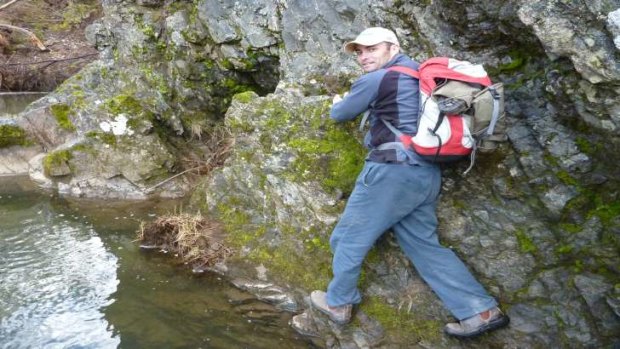
David Vincent rock hops along the banks of the Goodradigbee RiverCredit: Tim the Yowie Man
Just swing your legs over and grab onto that ledge,’’ yells Dave Vincent while pointing frantically to a tiny rock overhang jutting out of the moss-covered cliff. ‘‘Oh, and don’t fall in,’’ he warns wryly.
Dave’s instructions are clear enough, but with my fingers trembling from the cold, and the icy Goodradigbee, a fast-flowing trout stream that leaps from its birthplace in the high plains of Kosciuszko National Park, churning several metres below, it’s hard to execute.
Eventually, I conjure up enough courage and, with all the coordination of a tranquilised elephant, leap across to the rock ledge.
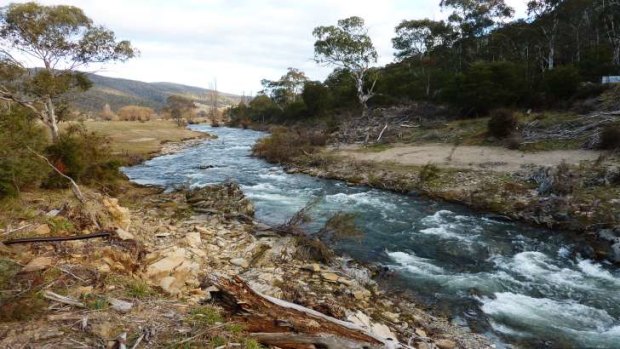
The floods of March 2012 have scoured out the banks Goodradgibee River which flows through the Brindabella ValleyCredit: Tim the Yowie Man
Phew, I’ve made it! ‘‘
The going wasn’t this tough last time,’’ apologises Dave, a keen fly fisher, explaining that the one in a 100 years flood in March this year gouged out the sides of the Goodradigbee, which flows through the Brindabella Valley, 40 kilometres to Canberra’s west. The resulting new and deeper channels mean his promise of ‘‘three easy river crossings and a gentle stroll’’ have turned into a precarious rock hop along a blackberry-infested cliff-face to reach our destination. Nonetheless we push on.
Almost as passionate as Dave’s quest for prized trout is his thirst for local history. And it’s not surprising, the rich pioneering history of this valley runs in his blood – literally. His grandfather Gerry Kilmartin, was a former prominent Canberran who did a lot of stock trading in the Brindabella Valley mid last century and it was from Gerry that Dave inherited a rare copy of George Patterson’s Chasing Rainbows: Happy Days Along the Trout Streams (Halstead Press Sydney, 1959), a story from which prompted today’s expedition.
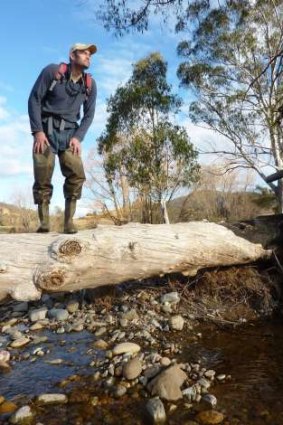
David Vincent on the lookout for Buddy’s graveCredit: Tim the Yowie Man
So was Patterson’s yarn about a monster-sized rainbow or an elusive bunyip that lurks in a bottomless waterhole? No, it’s about the grave of a dog. Yes, your Akubra-clad columnist is risking life and limb to reach the final resting place of a pet.
‘‘The dog, named Buddy, belonged to Bob Reid, a short-tempered World War One digger-come-hermit who called this valley home in the 1930s,’’ explains Dave. ‘‘Bob built himself a wattle and daub hut where he lived with Buddy, making a living doing odd jobs around the valley.’’
So attached was Bob to his canine mate, that when Buddy became so sick that he had to be put down, Bob couldn’t face the job himself, and asked a neighbour to do the deed for him.
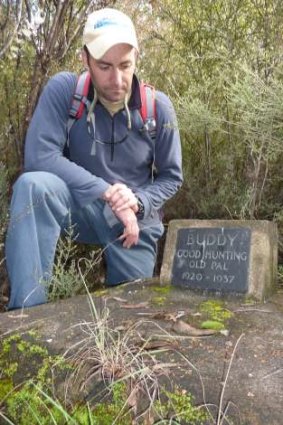
Dave Vincent pays his respects at Buddy’s grave, still marked by a plaque.Credit: Tim the Yowie Man
‘‘It must have been a bitter blow for this strange man, who, in a sorrowing fury, burned his hut to the ground, destroyed his garden, and, carrying a few personal belongings, he disappeared out west – ‘back o’ beyond’,’’ writes Patterson.
Eventually we emerge from the blackberries and on to a bend in the river known as Perkins Flat. Accessible in summer via a road through private property, this was the location of Bob Reid’s two riverside huts and the final resting place of Buddy.
‘‘It wasn’t easy finding the grave,’’ recalls Dave of his pre-flood effort last year. ‘‘I knew from the descriptions that it had to be near here so kept looking, and sure enough eventually stumbled upon it.’’
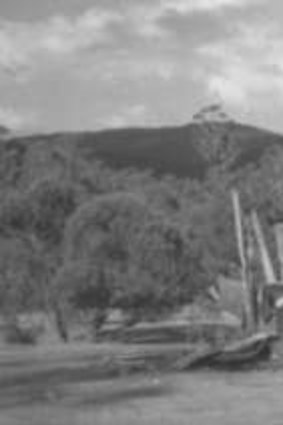
Bob Reid’s second hut at Perkins Flat in the Brindabella Valley.Credit: Beverley Bluett Johnson
Dave must have a photographic memory, for he leads me through the maze of tea tree thickets, which have sprung up since the 2003 fires, past the location of Bob’s first hut and market garden (still marked by stones) and straight to Buddy’s gave.
Apart from a wayward bird dropping, the inscription on the bronze plaque, which is proudly mounted on a plinth of concrete, is in near-perfect condition.
It reads: BUDDY, Good Hunting, Old Pal, 1920-1937.
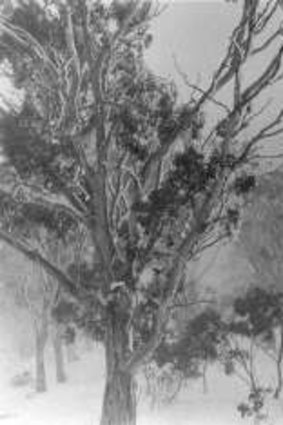
Bill Ginn’s Hut near the Mt Franklin Ski Chalet in August 1955. This small hut stood behind the Chalet and was built by Bob ReidCredit: Franklin Collection, Michael Barnett photo
‘‘To construct a memorial of this substance in the middle of the bush is an indication of how much Buddy must have meant to Bob,’’ explains Dave.
It turns out that the torching of his riverside hut after Buddy’s death wasn’t the end of Bob’s pyromaniac tendencies. Several months later, Bob returned to the valley where he built a second hut of rough-hewn slabs, deliberately remote from Buddy’s grave. Bob also created a gladiola garden, the corms of which he sold to stores in Sydney, and in 1938 he accepted a job as cook at the Mt Franklin Ski Chalet (sadly razed in the January 2003 bushfire). To minimise travel time up the steep and twisting road, Bob built yet another hut, this one just behind the chalet.
However, Bob’s tenure in the chalet’s kitchen didn’t last long and ended in a fiery exit. In his definitive book on pioneering life on the mountain range which holds up Canberra’s western horizon, Skis on the Brindabellas (Tabletop Press, 1994), Matthew Higgins reports that one day in the heat of an argument with some club members ‘‘Old Bob [as he was affectionately known to members] threatened the group with a breadknife, tried to burn down his slab hut...and stormed off into the Brindabella Valley in pitch darkness.’’
Following this unsavoury event, Old Bob lived on in the valley ‘‘for many years’’ until his death, which Higgins describes in somewhat macabre, if not comical, detail.
‘‘...one day John Bluett [a neighbour] found him in his hut dead from pneumonia. He’d been dead for four or five days and this was too much for Bluett so when four Yass police came to get the body, John Dowling [of nearby Brindabella Station] had to help them. Old Bob was in a sitting position with his arms folded. He was by now very stiff. John and the burly police had a real battle to straighten out Bob’s body and get it into the coffin. ‘Every time you let go,’ recalls John, ‘he’d bounce back up again!’ ’’
With clouds gathering upstream and the sun dropping quickly in the west, and not wanting to end up the same way as poor Old Bob, after a minute’s silence in memory of Buddy we embark on the crash and crawl home along the river.
On the way back, we marvel at what a wild and beautiful (apart from the blackberries) valley this is. Little wonder it inspired celebrated author Miles Franklin to write Childhood at Brindabella, and later from a remote log cabin at its top end Gwen Meredith to churn out copious episodes of her long-running ABC radio serial Blue Hills.
While wading across the Goodradigbee for one last time, Dave discloses his wish to see a sign erected near Buddy’s grave which chronicles the story of Bob Reid.
I agree – this year marks the 75th anniversary of Buddy’s death and in a valley famous for its storytellers, a small sign relating the fascinating tale of ‘‘Old Bob’’ at the final resting place of his loyal companion would be a fitting tribute.
FACT FILE
Did You Know? Some suggest that Bob Reid’s cantankerous nature may have been attributable to his love for alcohol and also pain caused by a metal plate in his head (possibly as a result of a war injury). Even changes in the weather were said to affect his mood.
A fiery end. The hut Bob Reid built behind the Mt Franklin Chalet in 1938 (and soon after attempted to burn down) was subsequently used as a meeting and ‘‘carousing’’ room by members of the Canberra Alpine Club, and also as a woodshed. In 1957, by which time it had no door, the hut (then known as Bill Ginn’s hut) accommodated the overflow of guests during the Balmain Cup – a weekend of competition skiing – who in an attempt to keep warm almost unintentionally set the hut on fire. However, the hut’s fiery end was sealed in 1961 when after being trucked to a block of land in Burra to form the basis of a new hut, a bushfire destroyed its slabs.
Can you help? Although the location of Buddy’s grave is known, does anyone know where the final resting place of his master, Bob Reid, is? I’m also keen to find out what breed of dog Buddy was. Dave Vincent and I both suspect a kelpie cross of sorts, but does anyone know for sure?
Sign up for the Traveller newsletter
The latest travel news, tips and inspiration delivered to your inbox. Sign up now.